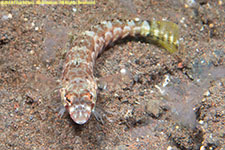 Yellowtail sandperch, Parapercis sp.
Yellowtail sandperch, Parapercis sp.Fish:
NOTE: We are not experts on the fish of Indonesia. If you find we have misidentified something, or you can identify something we could not, please contact us.
Sand perches are benthic fish which normally live over sand or rubble substrates in shallow seas. They tend to sit on the sea bed propped up by their widely-separated pelvic fins.
 Yellowtail sandperch, Parapercis sp.
Yellowtail sandperch, Parapercis sp.
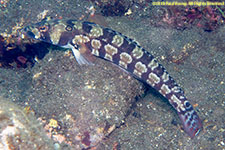 Reticulated sandperch, Parapercis tetracantha
Reticulated sandperch, Parapercis tetracantha
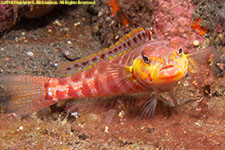
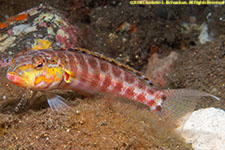
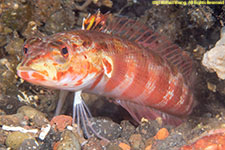 Red-spotted sandperch, Parapercis schauinslandi
Red-spotted sandperch, Parapercis schauinslandi
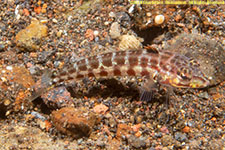 Nose-stripe sandperch, Parapercis lineopunctata
Nose-stripe sandperch, Parapercis lineopunctata
Puffers are related to porcupinefish but their spines are only visible when the fish has puffed up. They have four large teeth that are fused into an upper and lower plate, used for crushing crustaceans and mollucs for food. Most are toxic.
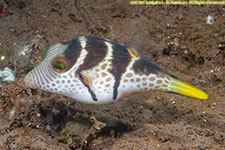 Black-saddled toby, Canthigaster valentini
Black-saddled toby, Canthigaster valentini
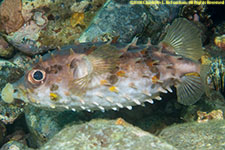 Yellowspotted burrfish, Cyclichthys spilostylus
Yellowspotted burrfish, Cyclichthys spilostylus
Lionfish, stonefish and scorpionfish: Lionfish are veneomous marine fish with conspicuous warning coloration, showy pectoral fins, and venomous spiky fin rays. Stonefish are some of the most venomous fish known. The potent neurotoxins are secreted from glands at the base of the needle-like dorsal fin spines, which stick up when the fish is threatened. Scorpionfish have sharp spines coated with venomous mucus.
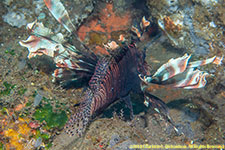 Common lionfish, Pterois volitans
Common lionfish, Pterois volitans
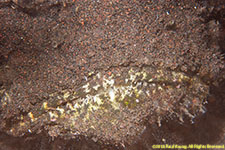 Reef stonefish, Synaneia verrucosa
Reef stonefish, Synaneia verrucosa
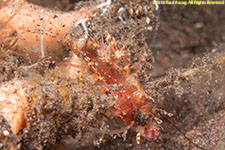 Papuan scorpionfish, Scorpaenopsis papuensis
Papuan scorpionfish, Scorpaenopsis papuensis
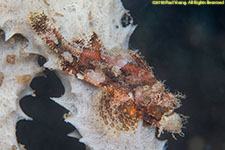 Tassled scorpionfish, Scorpaenopsis oxycephala
Tassled scorpionfish, Scorpaenopsis oxycephala
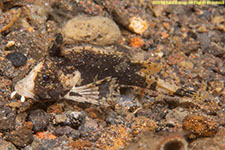 Wasp-spine velvetfish, Acanthosphex leurynnis
Wasp-spine velvetfish, Acanthosphex leurynnis
Pipefishes look like straight-bodied seahorses with tiny mouths. The snout is a long tube, ending in a narrow and small mouth which opens upwards and is toothless. They have a highly modified skeleton formed into armored plating. The gill openings are very small. Ghost pipefishes are related to pipefishes and seahorses. They feed on tiny crustaceans which they suck into their long snouts. Ghost pipefish females brood their eggs in their enlarged pelvice fins.
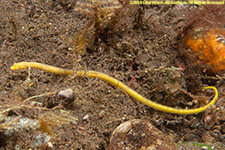
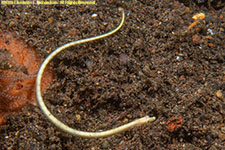 Briarium pipefish, Apterygocampus epinnulatus
Briarium pipefish, Apterygocampus epinnulatus
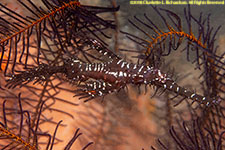 Ornate ghost pipefish, Solenostomus paradoxus
Ornate ghost pipefish, Solenostomus paradoxus
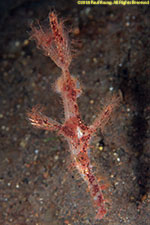 Roughsnout ghost pipefish, Solenostomus paegnius
Roughsnout ghost pipefish, Solenostomus paegnius
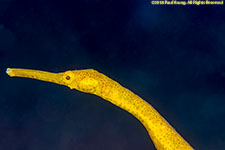 Short-tailed pipefish, Trachyrhamphus bicoarctatus
Short-tailed pipefish, Trachyrhamphus bicoarctatus
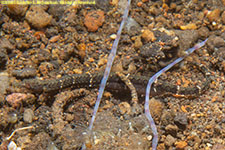 Schultz's pipefish, Corythoichthys cf schultzi
Schultz's pipefish, Corythoichthys cf schultzi
Gobies are small to medium-sized ray-finned fish with large heads and tapered bodies.
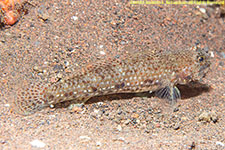 Orangetip sandgoby, Istigobius decoratus
Orangetip sandgoby, Istigobius decoratus
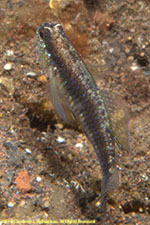 Starry goby, Asteropteryx cf semipunctatus
Starry goby, Asteropteryx cf semipunctatus
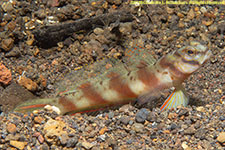 Redbarred shrimpgoby, Amblyeleotris sp.
Redbarred shrimpgoby, Amblyeleotris sp.
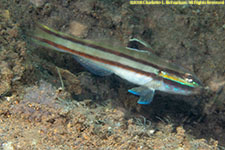 Twostripe goby, Valenciennea helsdingenii
Twostripe goby, Valenciennea helsdingenii
Blennies are small fish with elongated bodies and relatively large eyes and mouths,
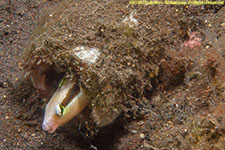 False cleanerfish, Aspidontus taeniatus
False cleanerfish, Aspidontus taeniatus
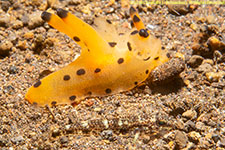 Four-fingered blenny, Andamia tetradctylus (with nudibranch)
Four-fingered blenny, Andamia tetradctylus (with nudibranch)
Frogfish are small, short, stocky, camouflaged fish. Many species can change color, and some are covered with other organisms such as algae or hydrozoa. They move slowly, lying in wait for prey, and then strike extremely rapidly.
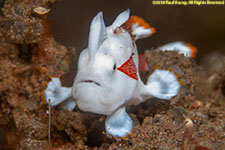 Warty frogfish, Antennarius maculatus (juvenile)
Warty frogfish, Antennarius maculatus (juvenile)
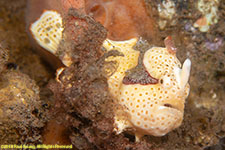
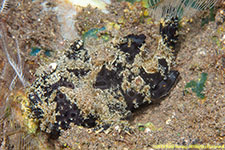
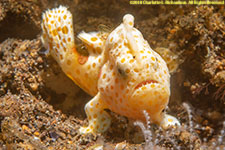 Painted frogfish, Antennarius pictus
Painted frogfish, Antennarius pictus
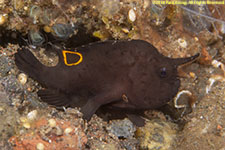 Ocellated frogfish, Antennarius sp.
Ocellated frogfish, Antennarius sp.
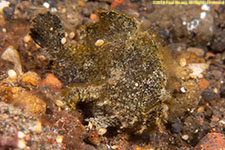 Giant frogfish, Antennarius commersoni
Giant frogfish, Antennarius commersoni
Eels: Moray eels have a dorsal fin which extends from just behind the head along the back and joins seamlessly with the caudal and anal fins. Most species lack pectoral and pelvic fins, Their eyes are relatively small; they rely on their sense of smell instead. Ribbon eels are found in Indo-Pacific lagoons and reefs. They have long, thin bodies and high dorsal fins.
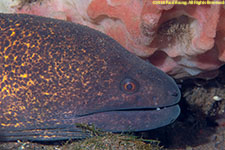 Yellowmargin moray, Gymnothorax flavimarginatus
Yellowmargin moray, Gymnothorax flavimarginatus
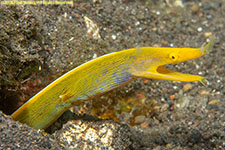 Ribbon eel, Rhinomuraena quaesita (female)
Ribbon eel, Rhinomuraena quaesita (female)
Wrasses are a highly-diverse family of small fish. Theu are efficient carnivores, feeding on a wide range of small invertebrates.
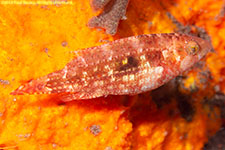
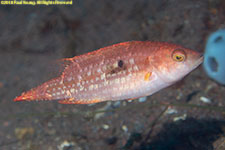 Slender wrasse, Oxycheilinus orientalis
Slender wrasse, Oxycheilinus orientalis
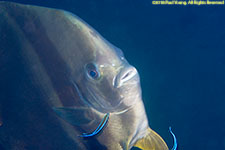 Bluestreak cleaner wrasse, Labroides dimidiatus (juvenile), on batfish
Bluestreak cleaner wrasse, Labroides dimidiatus (juvenile), on batfish
Butterflyfish are brightlhy colored and strikingly patterned fish with deep, laterally narrow bodies.
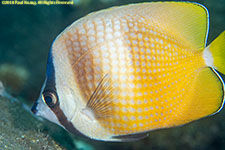 Klein's butterflyfish, Chaetodon kleinii
Klein's butterflyfish, Chaetodon kleinii
©2019, 2020, 2024 Mermaid Underwater Photographic. All Rights Reserved.
Contact us at mermaid@underwater.org.
Last modified 30 October 2024